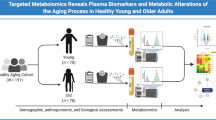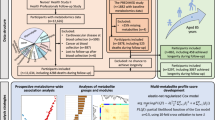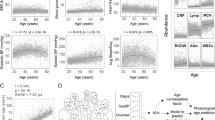Abstract
Chronological age is an important predictor of morbidity and mortality; however, it is unable to account for heterogeneity in the decline of physiological function and health with advancing age. Several attempts have been made to instead define a “biological age” using multiple physiological parameters in order to account for variation in the trajectory of human aging; however, these methods require technical expertise and are likely too time-intensive and costly to be implemented into clinical practice. Accordingly, we sought to develop a metabolomic signature of biological aging that could predict changes in physiological function with the convenience of a blood sample. A weighted model of biological age was generated based on multiple clinical and physiological measures in a cohort of healthy adults and was then applied to a group of healthy older adults who were tracked longitudinally over a 5–10-year timeframe. Plasma metabolomic signatures were identified that were associated with biological age, including some that could predict whether individuals would age at a faster or slower rate. Metabolites most associated with the rate of biological aging included amino acid, fatty acid, acylcarnitine, sphingolipid, and nucleotide metabolites. These results not only have clinical implications by providing a simple blood-based assay of biological aging, but also provide insight into the molecular mechanisms underlying human healthspan.




Similar content being viewed by others
References
Barallobre-Barreiro J, Chung Y-L, Mayr M (2013) Proteomics and metabolomics for mechanistic insights and biomarker discovery in cardiovascular disease. Rev Esp Cardiol (Engl Ed) 66:657–661
Belsky DW, Caspi A, Houts R, Cohen HJ, Corcoran DL, Danese A, Harrington H, Israel S, Levine ME, Schaefer JD, Sugden K, Williams B, Yashin AI, Poulton R, Moffitt TE (2015) Quantification of biological aging in young adults. Proc Natl Acad Sci U S A 112:E4104–E4110
Blair SN, Kohl H, Paffenbarger RS, Clark DG, Cooper KH, Gibbons LW (1989) Physical fitness and all-cause mortality. JAMA. 262:2395–2401
Bradshaw DI, George JD, Hyde A, LaMonte MJ, Vehrs PR, Hager RL, Yanowitz FG (2005) An accurate VO2max nonexercise regression model for 18–65-year-old adults. Res Q Exerc Sport 76:426–432
Brooks-Wilson AR (2013) Genetics of healthy aging and longevity. Hum Genet 132:1323–1338
Calle EE, Thun MJ, Petrelli JM, Rodriguez C, Heath CW Jr (1999) Body-mass index and mortality in a prospective cohort of U.S. adults. N Engl J Med 341:1097–1105
Cao Z-B, Miyatake N, Higuchi M, Miyachi M, Ishikawa-Takata K, Tabata I (2010) Predicting VO2max with an objectively measured physical activity in Japanese women. Med Sci Sports Exerc 42:179–186
Cho IH, Park KS, Lim CJ (2010) An empirical comparative study on biological age estimation algorithms with an application of Work Ability Index (WAI). Mech Ageing Dev 131:69–78
Clasquin MF, Melamud E, Rabinowitz JD (2012) LC-MS data processing with MAVEN: a metabolomic analysis and visualization engine. Curr Protoc Bioinformatics. Chapter 14, Unit14 11
Finkel T (2015) The metabolic regulation of aging. Nat Med 21:1416–1423
Fleg JL, Morrell CH, Bos AG, Brant LJ, Talbot LA, Wright JG, Lakatta EG (2005) Accelerated longitudinal decline of aerobic capacity in healthy older adults. Circulation. 112:674–682
Franceschi C, Campisi J (2014) Chronic inflammation (inflammaging) and its potential contribution to age-associated diseases. J Gerontol A Biol Sci Med Sci 69(Suppl 1):S4–S9
Hannum G, Guinney J, Zhao L, Zhang L, Hughes G, Sadda S, Klotzle B, Bibikova M, Fan JB, Gao Y, Deconde R, Chen M, Rajapakse I, Friend S, Ideker T, Zhang K (2013) Genome-wide methylation profiles reveal quantitative views of human aging rates. Mol Cell 49:359–367
Hasek BE, Stewart LK, Henagan TM, Boudreau A, Lenard NR, Black C, Shin J, Huypens P, Malloy VL, Plaisance EP, Krajcik RA, Orentreich N, Gettys TW (2010) Dietary methionine restriction enhances metabolic flexibility and increases uncoupled respiration in both fed and fasted states. Am J Phys Regul Integr Comp Phys 299:R728–R739
Horvath S (2013) DNA methylation age of human tissues and cell types. Genome Biol 14:R115
Houtkooper RH, Argmann C, Houten SM, Canto C, Jeninga EH, Andreux PA, Thomas C, Doenlen R, Schoonjans K, Auwerx J (2011) The metabolic footprint of aging in mice. Sci Rep 1:134
Jackson AS, Blair SN, Mahar MT, Wier LT, Ross RM, Stuteville JE (1990) Prediction of functional aerobic capacity without exercise testing. Med Sci Sports Exerc 22:863–870
Jiang T, Yu J-T, Tian Y, Tan L (2013) Epidemiology and etiology of Alzheimer’s disease: from genetic to non-genetic factors. Curr Alzheimer Res 10:852–867
Johnson LC, Martens CR, Santos-Parker JR, Bassett CJ, Strahler TR, Cruickshank-Quinn C, Reisdorph N, McQueen MB, Seals DR (2018) Amino acid and lipid associated plasma metabolomic patterns are related to healthspan indicators with ageing. Clin Sci 132:1765–1777
Kennedy BK, Berger SL, Brunet A, Campisi J, Cuervo AM, Epel ES, Franceschi C, Lithgow GJ, Morimoto RI, Pessin JE, Rando TA, Richardson A, Schadt EE, Wyss-Coray T, Sierra F (2014) Geroscience: linking aging to chronic disease. Cell. 159:709–713
Kim S, Myers L, Wyckoff J, Cherry KE, Jazwinski SM (2017) The frailty index outperforms DNA methylation age and its derivatives as an indicator of biological age. Geroscience. 39:83–92
Klemera P, Doubal S (2006) A new approach to the concept and computation of biological age. Mech Ageing Dev 127:240–248
Lanza IR, Short DK, Short KR, Raghavakaimal S, Basu R, Joyner MJ, McConnell JP, Nair KS (2008) Endurance exercise as a countermeasure for aging. Diabetes. 57:2933–2942
Laukkanen JA, Kurl S, Salonen R, Rauramaa R, Salonen JT (2004) The predictive value of cardiorespiratory fitness for cardiovascular events in men with various risk profiles: a prospective population-based cohort study. Eur Heart J 25:1428–1437
Lawton KA, Berger A, Mitchell M, Milgram KE, Evans AM, Guo L, Hanson RW, Kalhan SC, Ryals JA, Milburn MV (2008) Analysis of the adult human plasma metabolome. Pharmacogenomics. 9:383–397
Levine ME (2013) Modeling the rate of senescence: can estimated biological age predict mortality more accurately than chronological age? J Gerontol A Biol Sci Med Sci 68:667–674
López-Otín C, Galluzzi L, Freije JM, Madeo F, Kroemer G (2016) Metabolic control of longevity. Cell. 166:802–821
Lunenfeld B, Stratton P (2013) The clinical consequences of an ageing world and preventive strategies. Best Pract Res Clin Obstet Gynaecol 27:643–659
Mapstone M, Cheema AK, Fiandaca MS, Zhong X, Mhyre TR, MacArthur LH, Hall WJ, Fisher SG, Peterson DR, Haley JM (2014) Plasma phospholipids identify antecedent memory impairment in older adults. Nat Med
Mitnitski A, Song X, Rockwood K (2013) Assessing biological aging: the origin of deficit accumulation. Biogerontology. 14:709–717
Nakamura E (1991) A study on the basic nature of human biological aging processes based upon a hierarchical factor solution of the age-related physiological variables. Mech Ageing Dev 60:153–170
Nemkov T, Hansen KC, D’Alessandro A (2017) A three-minute method for high-throughput quantitative metabolomics and quantitative tracing experiments of central carbon and nitrogen pathways. Rapid Commun Mass Spectrom 31:663–673
Nes BM, Janszky I, Vatten LJ, Nilsen T, Aspenes ST, Wisloff U (2011) Estimating VO2 peak from a nonexercise prediction model: the HUNT Study, Norway. Med Sci Sports Exerc 43:2024–2030
Noland RC, Koves TR, Seiler SE, Lum H, Lust RM, Ilkayeva O, Stevens RD, Hegardt FG, Muoio DM (2009) Carnitine insufficiency caused by aging and overnutrition compromises mitochondrial performance and metabolic control. J Biol Chem 284:22840–22852
Peters MJ, Joehanes R, Pilling LC, Schurmann C, Conneely KN, Powell J, Reinmaa E, Sutphin GL, Zhernakova A, Schramm K (2015) The transcriptional landscape of age in human peripheral blood. Nat Commun 6:8570
Ross R, Blair SN, Arena R, Church TS, Despres JP, Franklin BA, Haskell WL, Kaminsky LA, Levine BD, Lavie CJ, Myers J, Niebauer J, Sallis R, Sawada SS, Sui X, Wisloff U, American Heart Association Physical Activity Committee of the Council on L, Cardiometabolic H, Council on Clinical C, Council on E, Prevention, Council on C, Stroke N, Council on Functional G, Translational B, Stroke C (2016) Importance of assessing cardiorespiratory fitness in clinical practice: a case for fitness as a clinical vital sign: a scientific statement from the American Heart Association. Circulation. 134:e653–e699
Sebastiani P, Thyagarajan B, Sun F, Schupf N, Newman AB, Montano M, Perls TT (2017) Biomarker signatures of aging. Aging Cell 16:329–338
Soltow QA, Jones DP, Promislow DE (2010) A network perspective on metabolism and aging. Integr Comp Biol 50:844–854
Sui X, LaMonte MJ, Blair SN (2007) Cardiorespiratory fitness as a predictor of nonfatal cardiovascular events in asymptomatic women and men. Am J Epidemiol 165:1413–1423
Sun L, Sadighi Akha AA, Miller RA, Harper JM (2009) Life-span extension in mice by preweaning food restriction and by methionine restriction in middle age. J Gerontol A Biol Sci Med Sci 64:711–722
Wells JC (2007) Sexual dimorphism of body composition. Best Pract Res Clin Endocrinol Metab 21:415–430
Xia J, Wishart DS (2016) Using MetaboAnalyst 3.0 for comprehensive metabolomics data analysis. Curr Protoc Bioinformatics 55(14):10.1–14.10.91
Funding
This work was supported by National Institutes of Health awards T32 AG00027912 and Colorado CTSA UL1TR001082.
Author information
Authors and Affiliations
Contributions
L.C.J. and C.R.M. conceived and developed the overall study design and collected data used in the biological aging model. K.P. established the mathematical models used to quantify biological age. K.P. and B.F.A. developed and packaged R scripts to execute the biological age algorithm. T.G.N. and A.D. conducted metabolomics analysis and contributed technical support. S.J. conducted dietary analyses. L.C.J. performed statistical analysis. L.C.J., C.R.M., and D.R.S. contributed critical input towards study design and manuscript development. All authors edited and approved the final version.
Corresponding author
Ethics declarations
All study procedures were reviewed and approved by the University of Colorado Boulder Institutional Review Board. Clinical and physiological measurements were performed at the University of Colorado Boulder Clinical Translational Research Center (CTRC). All study participants provided written informed consent after the nature, benefits, and risks of the study were explained.
Additional information
Publisher’s note
Springer Nature remains neutral with regard to jurisdictional claims in published maps and institutional affiliations.
About this article
Cite this article
Johnson, L.C., Parker, K., Aguirre, B.F. et al. The plasma metabolome as a predictor of biological aging in humans. GeroScience 41, 895–906 (2019). https://doi.org/10.1007/s11357-019-00123-w
Received:
Accepted:
Published:
Issue Date:
DOI: https://doi.org/10.1007/s11357-019-00123-w




